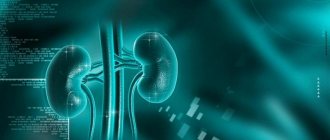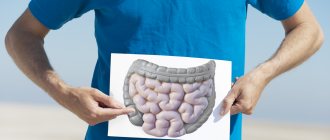Sometimes doctors observe kidney doubling, which is diagnosed in the fetus during intrauterine development. If there is a violation, an anomaly occurs in the development of the pyelocaliceal system, resulting in complete or partial division of the kidney. Moreover, each lobe of the organ has its own blood supply system. More often, pathology of one kidney is diagnosed, less often two are affected. Such an abnormal structure of the internal organ can threaten impaired urinary function. When doubling, therapeutic measures aimed at eliminating secondary infections are required. In particularly difficult situations, surgical procedures are prescribed.
Kidney duplication is a congenital pathology that can slightly or significantly affect the functionality of the organ.
What structure do healthy kidneys have?
The kidneys are a paired organ that is divided into two lobules. There is adipose and connective tissue around the organ, which prevents injury and damage. The renal pelvis and hilum are located in the concave part of the organ. Also, 2 ureters depart from each kidney, through which urine enters the bladder. The lobes of both kidneys are separated by blood vessels. If for some reason anomalies occur during intrauterine development, then a doubling of the child’s kidney is noted. Also, a doubling of the renal capacity of the kidneys often occurs.
https://youtu.be/ypT9G0kOd3U
Diagnosis of anomaly
Could it be that such a deviation from the norm will go unnoticed in an adult? If no examination has been carried out on a newborn, then doubling in adults is diagnosed, as a rule, only after some kind of inflammatory process has begun. Sometimes this pathology is discovered by chance, during an ultrasound examination of another organ that is located next to the kidney.
Diagnosis of this anomaly occurs using cystoscopy (with this examination, three orifices of the ureter are visible instead of two). Another examination that can detect the presence of a double kidney is excretory urography (here you can see the increased size of the kidney, as well as the third pelvis and an extra ureter), as well as ultrasound.
If the ultrasound shows a deviation from the norm during the examination, the doctor will also prescribe other examination methods to confirm the diagnosis. When cystoscopy shows three ureters, the diagnosis is confirmed. To determine the size of the enlarged kidney, the presence or absence of the third calyceal pelvis and the third ureter, the doctor prescribes excretory urography.
Without such an examination, in the absence of side diseases and inflammation, the doubling of the kidney does not manifest itself in any way, so such anomalies do not cause any problems.
According to the International Classification of Diseases, 10th revision, this anomaly refers to congenital anomalies (malformations) of the urinary system and has an ICD 10 code - Q60-Q64.
Causes of kidney duplication
In humans, an additional kidney occurs for various reasons, which are congenital in nature. The splitting of a healthy organ occurs during intrauterine development. The doubling of an organ on one or both sides is influenced by the following negative sources:
Kidney duplication occurs in utero under the influence of hormones, radiation, and genetic abnormalities.
- hormonal therapy during pregnancy;
- lack of vitamins and minerals during intrauterine development;
- ionizing radiation;
- drug intoxication;
- smoking and drinking alcohol while pregnant.
Extra kidneys in children can occur if at least one of the parents suffered from such an illness. In this case, complete or incomplete doubling of the kidney on the right or left side is possible. According to statistics, renal twinning is more often recorded in the fairer sex. Doctors have not been able to fully figure out why women are more likely to suffer from doubling.
What happens when a full doubling occurs?
With complete doubling, two organs are formed at once. In rare cases, pathology is observed on both sides. Each double kidney has its own pelvicalyceal system. Sometimes one of the emergency response systems is not fully developed. Complete duplication of the kidney does not require surgical therapy, provided that the urinary process is not impaired. With such an anomaly, it is important to carefully monitor your health and be regularly examined by a nephrologist.
Incomplete doubling: the essence of the problem
Often, incompletely doubled buds are diagnosed, in which case incomplete doubling is noted. The disorder is characterized by the presence of one ureter, through which urine exits into the bladder. In rare cases, doctors observe the entry of the ureter of the double kidney into the vagina or intestines. With this disorder, urine may exit through the posterior opening or leak through the vagina.
Incomplete doubling of the kidney is more common, but this problem is in no way inferior to complete doubling.
Incomplete duplication of the left kidney is diagnosed much more often, while in the process of intrauterine development 2 rudiments of metanephrogenic blastoma are formed, which soon form 2 internal urinary organs.
The following morphology of incomplete organ duplication is distinguished:
- preservation of the joint capsule of daughter neoplasms;
- supplying each half of the organ with its own circulatory system;
- separation of the renal arteries in the renal sinus or the vessels arise directly from the aorta.
Symptoms
As a rule, partial doubling does not cause any special problems in life and is not accompanied by functional changes. Complete doubling is a more dangerous feature; it is often accompanied by an abnormal physiological structure and requires mandatory supervision by a specialist throughout life. The situation becomes more complicated if there is a doubling of the right kidney and the left one at the same time.
Often, the first signs of a special structure may appear during times of increased stress on the body, for example, during pregnancy in women, as well as during hypothermia or after lifting weights in men. In other cases, a structural anomaly due to vulnerability gradually leads to diseases of the urinary system and is accompanied by the following symptoms:
- disturbance of urination - urinary retention, pain and pain, weak stream;
- pain in the back of the lumbar region, which intensifies when tapping with the edge of the palm;
- urinary retention is a threatening condition that may be accompanied by symptoms of intoxication - nausea, vomiting, weakness, unpleasant body odor;
- increase in body temperature from subfebrile (37º-37.5ºC) to high values;
- hypertension - blood pressure higher than age norms;
- swelling (legs, body, face);
- sallow complexion.
These signs are accompanied by both diseases of the genitourinary system and disorders of functional abilities (for example, insufficient outflow of urine due to doubling and underdevelopment of the maxillary tract). If you have double kidneys, you should take care of your body and follow your doctor’s recommendations. In children, such symptoms can be acute and therefore require immediate hospitalization. Pregnant women should undergo regular monitoring of the condition of the baby's organs.
If the structure of the kidneys is abnormal, primary diseases of the urinary system or exacerbation of old ones can be provoked by:
- Pregnancy.
- Hormonal imbalance.
- Wrong lifestyle: bad habits, disruption of sleep and rest patterns.
- Hypothermia.
- Hard physical work.
- Sports activities involving heavy lifting or overload.
- Abuse of medications that affect kidney function.
- Insufficient consumption of clean water.
- Urinary tract infections.
What are the dangers of a double kidney?
Doubling the kidney on the right or left side entails negative consequences. Complications are most likely to develop with incomplete doubling, since in this case urodynamics are significantly impaired. Patients with duplication of the right or left kidney suffer from the following complications:
- inflammatory process in a paired organ;
- stone formation;
- hydronephrosis;
- tuberculosis lesions;
- nephroptosis;
- malignant or benign neoplasms.
If the patient also has vesicoureteral reflux, then the likelihood of an inflammatory reaction against the background of doubling increases significantly. Complications can progress over many years, disrupting the function of many systems in the body. Such disorders are difficult to respond to therapeutic measures and often bring only short-term results.
Why does this happen: the influence of nutrition, harmful substances, mutations
The reasons leading to this anomaly have not been fully elucidated, but it is believed that any negative factors, be it malnutrition or chemical toxins that affect the period of organ formation, can lead to a similar pathology. Thus, various types of radiation in the early stages of pregnancy, exposure to organic and inorganic chemical compounds, and hazardous industries play a significant role. Often this anomaly is inherited if one or both parents have a double kidney. Taking medications, poor nutrition or fasting, drinking alcohol and smoking, all these factors can play a negative role at the beginning of pregnancy. Hypovitaminosis can affect if the expectant mother’s diet is severely lacking in vitamins, especially group B and folic acid. Often, pathology occurs due to the combined, simultaneous influence of several negative factors.
What signs indicate illness?
If complete bifurcation is noted, then the signs are usually absent or not clearly visible. When the ureter is removed into the vaginal area, the patient exhibits signs of a different nature. Urine leakage is often seen, which occurs in adults and children. Doubling can be detected by the following pathological signs:
- swelling of the limbs and face;
- general weakness;
- pain in the lower back;
- cloudy urine;
- high temperature and pressure;
- pain when passing urine;
- feeling of nausea and vomiting;
- renal colic.
Possible consequences
Complications appear with complete doubling of the organ, when inflammation, stones, formations are present in the tissues of the urinary system, or urodynamics are disturbed. The following diseases often develop against the background of a congenital anomaly:
- pyelonephritis;
- cysts, kidney tumors;
- urolithiasis disease;
- hydronephrosis.
Any of the diseases threatens the child’s health, so we can say with confidence that double kidney syndrome in a child is a serious problem. If the pathology has developed in a healthy organ, the risk of complications is minimal, and the person himself can live his whole life without suspecting a split.
Why is kidney doubling dangerous? Incomplete doubling does not interfere with excretory function and does not cause any pathologies in either a child or an adult. However, complete doubling can cause complications associated with stagnation of urine and provoke a number of pathologies:
- pyelonephritis;
- urolithiasis (urolithiasis);
- hydronephrosis;
- tuberculosis;
- nephroptosis;
- polycystic disease;
- ureterocele (narrowing of the ureteral canal, causing the appearance of a round cyst-like formation in the intravesical section);
- tumors and other diseases.
What to do?
Importance of diagnosis
Kidney duplication is clearly diagnosed by hardware examination.
It is almost impossible to identify a bifurcated kidney on your own, even if the patient’s urinary process is disrupted, this can be mistaken for an inflammatory process in the organ, and not an abnormal structure. To detect pathology, you need to see a doctor and conduct a comprehensive diagnosis. Most often, doubling is accidentally detected on ultrasound during examination of other organs. When diagnosing, the following diagnostic methods are used, given in the table.
| Diagnostic methods | Procedures |
| Laboratory | General urine examination |
| Laboratory blood diagnostics | |
| Bacteriological culture of urine sediment | |
| Instrumental | Magnetic resonance urography |
| Ultrasound with Doppler | |
| Radiography | |
| Urography of ascending type | |
| Cystoscopic diagnosis | |
| Excretory urographic examination |
With the help of complex diagnostics, it is possible to identify organ growth, determine secondary pathologies and the degree of disorder. Diagnostics also allows you to select the most accurate therapy.
Effective treatment
The most effective treatment for kidney duplication involves surgery.
If there are no complications, then the violation does not pose a danger to the patient’s health. In case of complications, an individual treatment method is prescribed, which includes medications, folk remedies or surgical methods. Conservative therapy is based on the following measures:
- nutrition adjustments;
- prescription of broad-spectrum antibiotics;
- taking antispasmodic or analgesic medications that relieve pain.
In especially severe cases, when medications do not produce results, surgery is performed. Surgery is indicated for oncology, the formation of large stones or significant urinary disturbances. It is extremely rare for doctors to remove an internal organ. If the work is not completely disrupted, then heminephrectomy is performed, in which the diseased organ is partially excised. In case of renal failure, hemodialysis is indicated, which serves as preparation for organ transplantation.
Diagnostic measures
Timely assessment of the condition and structure of organs with unilateral and bilateral defects makes it possible to identify deviations in functioning and, if necessary, prescribe therapy. If the anomaly does not affect the condition of the body, does not cause disruptions in the functioning of the urinary system (in case of incomplete doubling of the kidney), then the attending physician gives recommendations on lifestyle and diet and prescribes an annual examination. In other cases, treatment with medications and sometimes surgery for renal problems is recommended.
If a developmental defect is suspected, as well as during an annual doubling examination, the following set of diagnostic measures is prescribed:
- Ultrasound diagnostics with examination of the blood supply to the organ (Dopplerography). Modern equipment makes it possible not only to determine the location and structure of the kidneys, but also to evaluate their structure, as well as the slightest changes in it. Ultrasound with Dopplerography determines blood flow in the organ and assesses the condition of the blood vessels. The procedure requires preparation: drink 0.5 liters of water an hour - the bladder should be full, do not eat for 8 hours before the test, exclude flour products and bread from the diet, as well as sweets, raw vegetables, and milk a day or two before the test. The fact is that some foods cause excess gas formation in the large intestine, which can distort the results of the study. An acceptable diet before an ultrasound of the abdominal organs is porridge, soups, boiled meat and fish. Young children and people suffering from flatulence are advised to take carminative medications before diagnosis. Children are recommended to drink water already in the ultrasound room, since due to their physiological characteristics it is difficult for them to restrain the urge to urinate.
- X-ray with the introduction of a contrast agent. Prescribed for pain, as well as for suspected kidney disease or chronic processes. Indispensable for complications - urolithiasis, the presence of tumors and others. The procedure is as follows: the patient is given an intravenous injection (or drip infusion) with a contrast agent, then a series of x-rays are taken to determine the state of the kidneys' excretory function. Preparation for the study is the same as for an ultrasound.
- A modern and more informative method is computed tomography using a contrast agent. Thanks to it, the pictures are three-dimensional, clear, with their help you can see the condition of the kidneys, as well as the vessels that feed them. CT and X-rays are contraindicated in pregnant women to avoid disturbances in fetal development.
- Magnetic resonance imaging - gives an idea of the structure of the organ, its functioning, the state of blood circulation, the presence of tumors, duplications, stones and other neoplasms. This is by far the best method for deep research. Prescribed for controversial diagnoses or suspected complications. The procedure is quite long - about 40 minutes. During the study, the patient is placed in a special closed tube, so MRI is not suitable for people with claustrophobia, as well as those suffering from diseases of the nervous system and mental health. The procedure can be performed on pregnant women when indicated.
- Cystoscopy is an instrumental type of diagnosis. It involves inserting a special catheter with a camera at the end into the urethra and bladder. Gives an idea of the condition of the mucous membrane of these organs. It is carried out to clarify certain diagnoses - urolithiasis (UCD), tumors, cystitis and urethritis.
To determine your general health, laboratory tests of blood and urine are recommended.
https://youtu.be/mUk1WaMbxlI
Is there any prevention?
Only planning a healthy pregnancy reduces the risk of kidney duplication.
Avoiding doubling is quite difficult, since this is a genetic anomaly, the development of which is difficult to influence. The correct way of life for a woman while carrying a baby will help reduce the risk. If the anomaly could not be avoided, then possible complications should be prevented. For this purpose, a healthy way of life, a balanced diet filled with useful elements, is indicated. Give up bad habits that cause doubling. The patient should perform light physical activity every day and become stronger. If kidney duplication is complicated by inflammation, then treatment should be started immediately.
Treatment methods
Treatment for doubling organ shares is aimed at eliminating secondary diseases, so pathology that occurs without complications does not require serious therapeutic measures.
The child is under medical observation by a nephrologist or urologist, periodically undergoes laboratory tests, and undergoes an ultrasound of the kidneys. The doctor recommends following a diet, avoiding hypothermia, maintaining hygiene, and treating all associated pathologies in a timely manner.
If duplication of two organs is diagnosed or there is a history of diseases of the urinary system, the doctor may prescribe therapeutic or surgical treatment.
Conservative therapy consists of taking medications to relieve inflammation, pain, improve kidney function, and slow or stop further progression of the disease.
It is considered important in treatment to adhere to a diet, the basis of which should be healthy, fortified foods, with the exception of salt, spicy and fatty foods. Therapeutic treatment can last several days or weeks, and it all depends on the degree of inflammation and the underlying disease.
Surgery for bifurcated kidneys is performed only when conservative therapy has not given a positive result. There are several methods of surgical treatment for congenital kidney anomalies, but such operations are indicated if other methods are powerless, and the kidneys themselves refuse to perform their functions:
- nephrectomy;
- antireflux surgery;
- kidney transplantation;
- hemodialysis.
The prognosis after surgical treatment is difficult to predict; it all depends on the degree of damage to the organ, concomitant pathologies, and the characteristics of the patient’s body.











